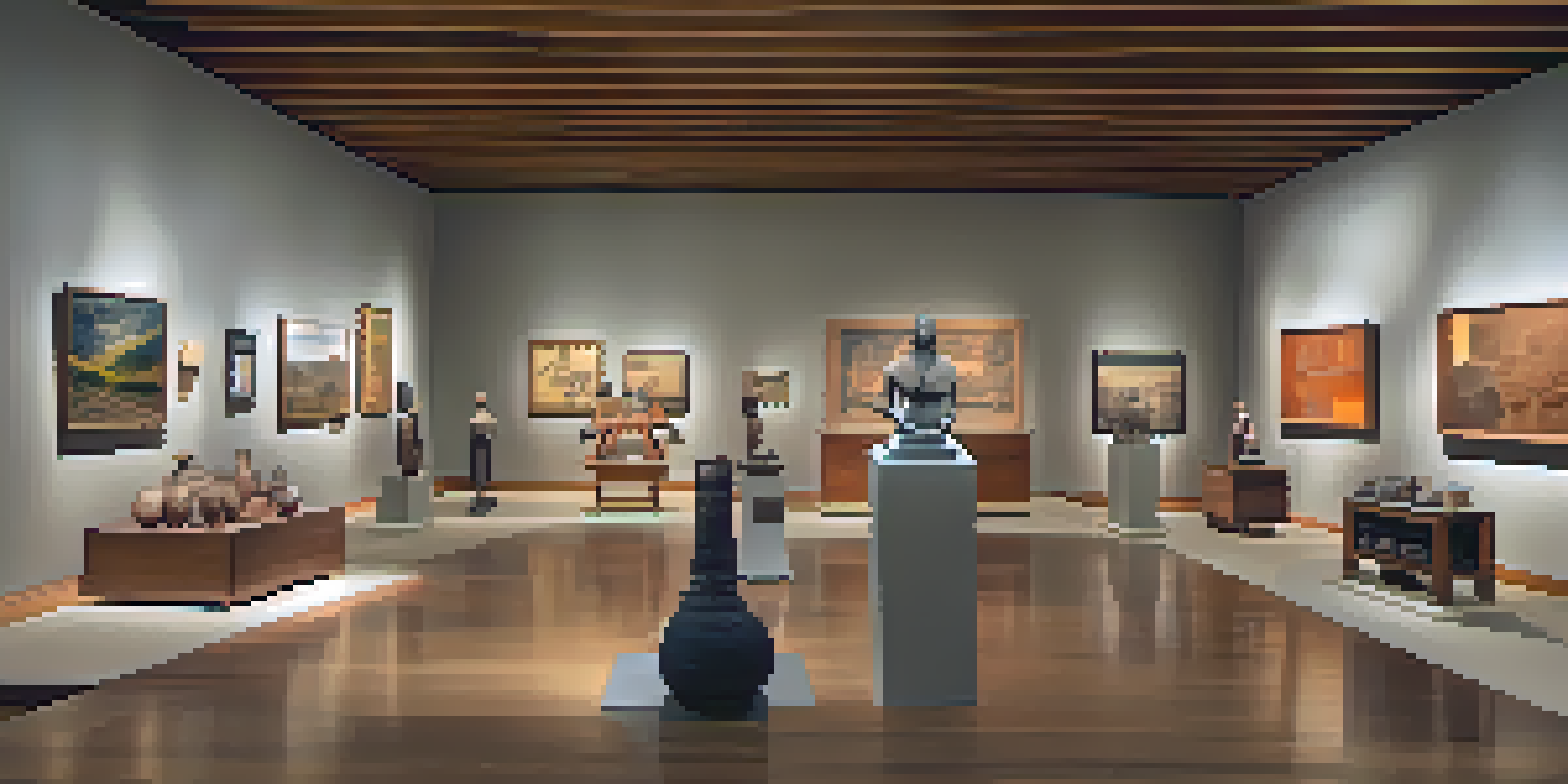Museums and Ethics: Responsibilities in Art Curation

Understanding the Role of Museums in Society
Museums serve as custodians of culture, preserving artifacts and artworks for future generations. They play a vital role in educating the public about history, art, and societal values. This responsibility extends beyond mere display; museums must engage with their communities and reflect diverse perspectives.
Museums are not just places where objects are kept; they are places where stories are born.
In this context, museums can influence cultural narratives and shape public understanding. The choices they make regarding which pieces to collect, exhibit, or interpret have lasting implications for society. Therefore, their role is not just about preservation but also about representation and inclusivity.
As such, the ethical implications of curation come into sharp focus. Museums must consider whose stories are being told and how, ensuring that marginalized voices are included and respected in their narratives.
The Ethics of Acquiring Artifacts
Acquisition ethics are at the heart of museum responsibilities. Museums must ensure that the artworks and artifacts they collect are obtained legally and ethically. This means verifying provenance, or the history of ownership, to avoid acquiring items that may have been looted or stolen.

For instance, many institutions now have policies in place to return artifacts to their countries of origin. Such actions not only rectify historical injustices but also foster goodwill and collaboration between museums and source communities. This highlights the importance of transparency in the acquisition process.
Museums as Cultural Stewards
Museums play a crucial role in preserving culture while engaging with diverse communities and narratives.
Ultimately, ethical acquisitions contribute to a museum's credibility and integrity. By adhering to ethical standards, museums can build trust with the public and the communities they serve.
Curation and Representation: Balancing Perspectives
Curation is not just about selecting art; it's about telling stories in a way that represents multiple viewpoints. Ethical curation involves recognizing biases and striving for a balanced representation of cultures and communities. This can be particularly challenging in a world where some narratives have historically dominated others.
A museum is a place where one should be able to learn from the past, not simply to look at it.
For example, curators must consider how to represent indigenous cultures authentically and respectfully. This often involves collaborating with community members to ensure their stories are told accurately. Such partnerships can enrich exhibitions and create a more inclusive narrative.
By prioritizing diverse perspectives in curation, museums can foster a deeper understanding of the complexities of art and history. This approach not only enhances the visitor experience but also promotes social responsibility.
Visitor Engagement: Education and Interpretation
Engaging visitors through education is a critical aspect of a museum's ethical responsibility. Museums have the opportunity to interpret artworks and artifacts in ways that promote understanding and critical thinking. This involves providing context and facilitating discussions around complex topics, including colonialism, race, and identity.
Interactive programs, workshops, and guided tours can encourage visitors to engage with exhibits on a deeper level. By creating spaces for dialogue, museums can help visitors grapple with challenging issues and reflect on their own perspectives. This is essential for fostering a more informed and empathetic society.
Ethics in Artifact Acquisition
Ensuring ethical acquisition practices helps museums maintain credibility and foster trust with the public.
Moreover, museums can serve as platforms for social change by addressing contemporary issues through their collections. By highlighting relevant themes, they can inspire action and advocacy among visitors.
The Impact of Technology on Museum Ethics
Technology is transforming the way museums operate, but it also raises new ethical questions. Digital exhibitions, virtual tours, and social media engagement can enhance access and reach a broader audience. However, museums must navigate issues around copyright, representation, and the authenticity of digital experiences.
For instance, when digitizing collections, museums must ensure they respect the rights of artists and their descendants. This includes obtaining permissions and providing appropriate credit, which can be complex in the digital realm. Balancing innovation with ethical considerations is crucial for maintaining integrity.
Additionally, as museums embrace technology, they must remain committed to inclusivity. Ensuring that digital content is accessible to all, including those with disabilities, is a fundamental aspect of ethical responsibility.
Sustainability and Ethical Practices in Museums
Sustainability is becoming an integral part of museum ethics, as institutions recognize their environmental responsibilities. This encompasses everything from energy-efficient buildings to sustainable exhibition practices. Museums must consider how their operations impact the planet and strive to minimize their carbon footprint.
For example, some museums are adopting green practices in their conservation efforts, using eco-friendly materials and methods. This not only protects the environment but also sets a positive example for visitors. By prioritizing sustainability, museums can contribute to a broader cultural shift toward environmental responsibility.
Navigating Future Ethical Challenges
As societal dynamics evolve, museums must adapt their practices to address issues like cultural appropriation and representation.
Ultimately, integrating sustainability into museum practices aligns with ethical curation. It reflects a commitment to future generations and the preservation of both culture and the natural world.
Future Challenges in Museum Ethics
As society evolves, museums will face new challenges regarding ethics in curation. Issues such as cultural appropriation, repatriation of artifacts, and the representation of marginalized communities will continue to be at the forefront. Museums must remain adaptable and responsive to these changing dynamics.
Additionally, the rise of social media and digital platforms poses unique challenges for museums in terms of engagement and representation. Curators must navigate the fine line between accessibility and authenticity, ensuring that digital representations do not dilute the meanings of the artworks.

By anticipating and addressing these challenges, museums can remain relevant and ethical in their practices. Embracing change while staying true to their core values will be essential for fostering trust and maintaining their role as cultural stewards.